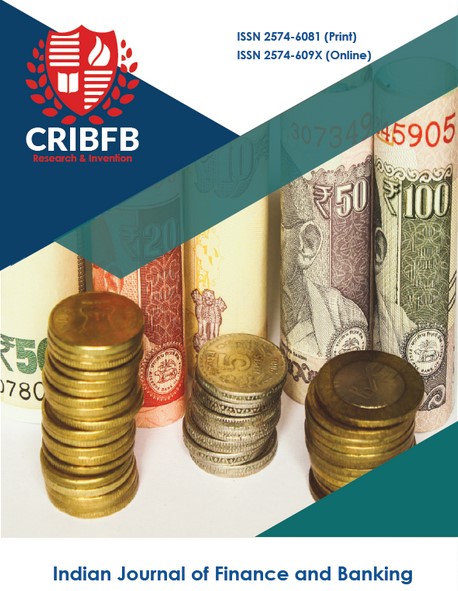INTERFERENCE OF ABORTION LAW ON THE RELATIONSHIP BETWEEN ECONOMIC DEVELOPMENT AND FERTILITY RATE OF WOMEN
Main Article Content
Abstract
The last few decades have seen unprecedented economic growth and fertility decline. However, the relationship between economic development and fertility rate varies across the countries due to country-specific characteristics. There are two schools of thought in the existing literature: the first holds that women's fertility declines with economic development, which happens in tandem with industrialization, while the second holds that fertility rises with economic development because it encourages early marriage, coupled with, increase in economic security. However, there is a dearth of information in the literature regarding how various birth control regulatory systems affect the connection between fertility and economic development. Therefore, the present study attempts to analyze the relationship between birthrate and growth of GDP per capita in 182 nations (using panel data from 1990 to 2012). The study has three major findings. First, it implies the U-shaped association between economic progress and fertility rate is not universal. Second, the law affects women's fertility. More abortion restrictions boost a woman's fertility. Finally, cultural influences like previous periods' fertility rates affect the current period's fertility, indicating an intertemporal link. The study contributes to the in-depth understanding of the determinants of fertility rate. It identified how the abortion law influence the relationship between economic development and fertility rate. The findings can help in designing the fertility control measures, based on a country’s status of economic development.
JEL Classification Codes: K42, O1, J13.
Downloads
Article Details
Section
How to Cite
References
Ashraf, Q. H., Weil, D. N., & Wilde, J. (2013). The effect of fertility reduction on economic growth. Population and Development Review, 39(1), 97-130. Retrieved from https://www.jstor.org/stable/41811954
Becker, G. S. (1981). A treatise on the family. Harvard University Press. Cambridge MA. Retrieved from https://brunofvieira.files.wordpress.com/2012/12/gary-becker-a-treatise-on-the-family.pdf
Bloom, D. E., Canning, D., & Fink, G. (2008). Urbanization and the wealth of nations. Science, 319(5864), 772-775. https://doi.org/10.1126/science.1153057
Bryant, J. (2007). Theories of fertility decline and the evidence from development indicators. Population and Development Review, 101-127. https://doi.org/10.1111/j.1728-4457.2007.00160.x
Bulatao, R. A. and Lee, R. D. (1983). Determinants of fertility in developing countries. Academic Press. New York, pp. 575–787. Retrieved from https://books.google.co.in/books/about/Determinants_of_Fertility_in_Developing.html?id=4ArZAAAAIAAJ&redir_esc=y
De Lange, M., Wolbers, M. H., Gesthuizen, M., & Ultee, W. C. (2014). The impact of macro-and micro-economic uncertainty on family formation in the Netherlands. European Journal of Population, 30(2), 161-185. https://doi.org/10.1007/s10680-013-9306-5
Easterlin, R. A., Pollack, R. A. and Waghter, M. L. (1980). Toward a more general economic model of fertility determination: Endogenous Preferences and Natural
Fertility. University Chicago Press. Chicago. Retrieved from https://www.nber.org/books-and-chapters/population-and-economic-change-developing-countries/toward-more-general-economic-model-fertility-determination-endogenous-preferences-and-natural
Giota Panopoulou & Panos Tsakloglou, (1999). Fertility and economic development: Theoretical considerations and cross-country evidence. Applied Economics, 31(11), 1337-1351. https://doi.org/10.1080/000368499323229
Heer, D. M. (1966). Economic development and fertility. Demography, 3(2), 423-444. https://doi.org/10.2307/2060168
Hoddinott, J. (1992). Rotten kids or manipulative parents: Are children old age security in Western Kenya?. Economic Development and Cultural Change, 40(3), 545-565. https://doi.org/10.1086/451960
Kuznets, S. (1967). Population and economic growth. Proceedings of the American Philosophical Society, 111(3), 170-193. Retrieved from https://www.jstor.org/stable/985714
Lacalle-Calderon, M., Perez-Trujillo, M., & Neira, I. (2017). Fertility and economic development: Quantile regression evidence on the inverse J-shaped pattern. European Journal of Population, 33(1), 1-31. https://doi.org/10.1007/s10680-016-9382-4
Landry, A. (1987). A Rdvolution Ddmographique.. Retrieved from https://www.jstor.org/stable/1973031
Luci-Greulich, A., & Thévenon, O. (2014). Does economic advancement cause a re-increase in fertility? An empirical analysis for OECD countries (1960–2007). European Journal of Population, 30(2), 187-221. https://doi.org/10.1007/s10680-013-9309-2
Mankiw, N. G., Romer, D., & Weil, D. N. (1992). A contribution to the empirics of economic growth. The quarterly journal of economics, 107(2), 407-437. https://doi.org/10.2307/2118477
Myrskyla, M., Kohler, H. P., & Billari, F. C. (2009). Advances in development reverse fertility declines. Nature, 460(7256), 741. https://doi.org/10.1038/nature08230
Nazmuddin, M. (2021). Debt, deficit, and economic growth in South Asia: A Comparative Analysis. In Development, Governance and Gender in South Asia (pp. 35-54). Springer, Singapore. Retrieved from https://link.springer.com/book/10.1007/978-981-16-5109-0
Notestein, F. W. (1945). Population–The long view, in food for the world. T. Schulz, Editor. Retrieved from https://u.demog.berkeley.edu/~jrw/Biblio/Eprints/126grad/Notestein/notestein.1945_pop.long.view.pdf
Poston, D. L. (2000). Social and economic development and the fertility transitions in mainland China and Taiwan. Population and Development Review, 26, 40-60. Retrieved from https://www.jstor.org/stable/3115211
Schultz, D. P. (1969). The human subject in psychological research. Psychological bulletin, 72(3), 214. https://doi.org/10.1037/h0027880
Wilson, C. (2004). Fertility below replacement level. Science, 304(5668), 207-209. https://doi.org/10.1126/science.304.5668.207c
Zhang, J., & Nishimura, K. (1993). The old-age security hypothesis revisited. Journal of Development Economics, 41(1), 191-202. https://doi.org/10.1016/0304-3878(93)90047-Q.




